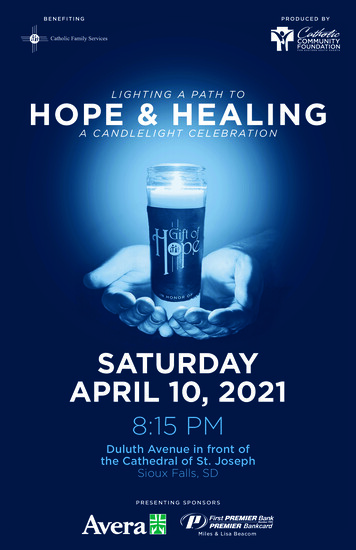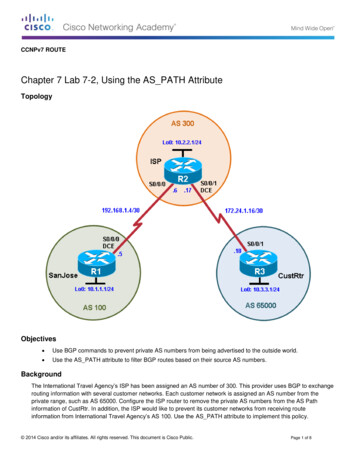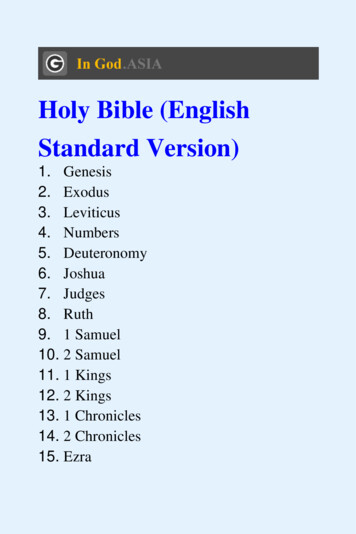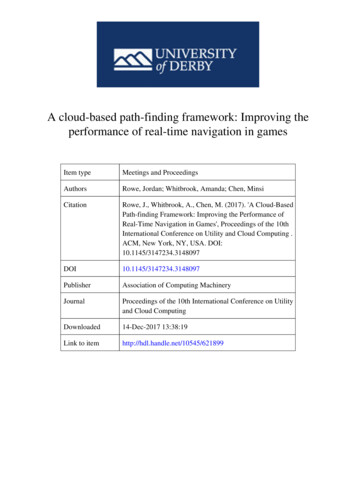
Transcription
The Path of the Black DragonBy Tomas Stacewicz
Tomas Stacewicz 2010In the Western or Hermetic external Alchemical traditions there mainly exists two majorpaths according to the subject matter, that of the Red and that of the Black Dragons. InHermetic Alchemy the Dragon signifies the First Matter or Prima Materia, the crude materialbasis that is to be subjected to the Great Work, or Opus Magnum. There are also distinct“ways” or “paths” which are related to the process itself, or the Modus Operandi of the GreatWork. They are basically three, the “wet” or “humid” way, the “dry” way, and lastly the“amalgams” or “mixed” way, the last one combining processes of both the dry and the wetways.In short the wet way uses glassware and a “secret fire”, as contrasted to the vulgar fire used inthe dry way, and therefore it is seen as the more noble of them both. The amalgams way usesboth the vulgar fire from the furnace (Athanor) and glassware. While the process of the wetway is more prolonged and take months rather than days to finish as with the dry way, usingheat from chemical reactions which reaches temperatures way below 500 C, the dry wayreaches very high temperatures approximating 1000 C.While there are several matters used with the wet way, such as the Vitriol (Sulphate salts) andthe Red Dragon, or Cinnabar (Mercury sulphide), there is a general agreement (however notuncontested) that the matter of the dry and amalgam ways concerns Antimony. Actually it isthe mineral and not the metal of Antimony that is being used, i.e. Stibnite (Antimonysulphide). This mineral (see following image) has several names in Alchemy, such as theBlack Dragon, the Scaly Dragon, the Grey Wolf, the Child (or Offspring) of Saturn, the FirstBorn or Saturn, Daughter of Saturn, Son of Saturn, and Venomous Serpent. A beloved childhas many names as we say in my native country of Sweden.
The Amalgams Way of Antimony was followed by Nicholas Flamel and EirenaeusPhilalethes, and Jean Dubuis, while the Wet Way of Vitriol was lead by Basil Valentinus andthat of Cinnabar by Kamala Jnana and Roger Caro, while the Dry Way of Antimony wasperpetuated by Basil Valentinus, Cyliani and Fulcanelli. This essay mainly concerns with theso-called “Dry Way of Antimony”, which has been popularised by the books of EugèneCanseliet (1899-1982), the beloved pupil of Fulcanelli (see following sketch of Fulcanelli byR. A. Schwaller dated 1930). Thus we will remain within the French Alchemical tradition andcontinue with its disclosure, an exposition that I started with my essay on The Path of the RedDragon.Today Fulcanelli is regarded as perhaps the greatest of the Masters of external Alchemy,revered by many modern students of the Hermetic Path. The name “Fulcanelli” is a pen nameor a “magical motto”, which may be translated into “The Sacred Fire” (from the roman godVulcan and the Canaanite god El). He only penned two books that have become modernclassics, Le Mystère des Cathédrales (“The Mystery of the Cathedrals”) from 1929, and LesDemeures Philosophales (“Dwellings of the Philosophers”) from 1930. A third book wasplanned but never came to be published, called Finis Gloriae Mundi (“End of the World’sGlory”), supposedly inspired by Fulcanelli’s favorite painting “Finis gloriae mundi”by Juàn de Valdès Léal (see following image).
Some claim Canseliet wrote or compiled these works using the notes from his master. PerhapsCanseliet (see a following picture of him working in his laboratory) was somewhat involvedin its editing as he wrote rather lengthy introductions to both, and later wrote several books onAlchemy using his own name, the most prominent being the L'Alchimie expliquée sur sestextes classiques. In this latter book, which never has been translated into English, Canselietquite openly describes the Dry Way of Antimony, and modern adherents of this way use bothit and Fulcanelli’s Les Demeures Philosophales as their main source material.It is said that already in his Dwellings of the Philosophers Fulcanelli were more generous thanhis predecessors in describing the Alchemical process, however scattered it may be throughhis work. But in the same vein as the old Masters of the Art, Fulcanelli also resorted to veiledsymbolism in his descriptions. This has of course led to different interpretations about thenature of the process, and even about the very Matter of choice, i.e. the identity of the BlackDragon or Daughter of Saturn as Fulcanelli calls it. It’s a fact that even Canseliet sometimescontradicts Fulcanelli, if we are to interpret Fulcanelli literately. And this polemic stillcontinues today and a recent one on two Yahoo forums moderated by the PortugueseAlchemist Rubellus Petrinus actually inspired me to write this piece.
Fulcanelli himself believed that he was the pupil of Basilius Valentinus, the famous Germanalchemist supposedly born in 1394 (see previous woodcut). Canseliet claim Fulcanelli wasborn in 1839 and there are many other fantastic stories attached to his character, as forexample Canseliet meeting his old master in 1953 for the first time after his disappearance,after the end of World War II, and in a much more younger appearance and vigour at that. Heis of course reputed to have successfully transmuted led into gold through Projection alreadyin the 1920’s.However the identity of Fulcanelli is still shrouded in a veil of mystery, even if Canseliet leftus some clues. Several names and identities have been proposed, all French, such as thepainter Jean-Julien Champagne (1877-1932), the scientist Jules Violle (1841-1923), therenowned alchemist François Jollivet-Castelot (1876-1939), which figures on a famouspicture taken from his laboratory (see previous image), and even Canseliet himself (althoughthat last suggestion seems to be the least probable). However if the suggestions regardingJollivet-Castelot are correct, this clearly ties him with Cyliani, through G F Tiffereau whoreportedly knew Jollivet-Castelot. Most believe him to have been Champagne because of thesimilar physical appearance (see below portrait of Champagne from 1930 to the right andcompare it to the drawing of Fulcanelli above).
The name Fulcanelli is closely attached to an occult group called Frères d'Heliopolis(“Brotherhood of Heliopolis”), which included Canseliet, Champagne and Jules Boucher(1902-1955). Some maintain that Fulcanelli was the founder and head of this Brotherhood.Now this fellow Boucher is interesting besides the other three because of his merits which helater earned as a Martinist, as he later lead the group called l'Ordre Martiniste Rectifié(O:::M:::R:::), founded in 1948 claiming lineage to Robert Ambelain (1907-1997). The fact isthat Boucher (see his ex libris in the following image) lead a earlier group together withAmbelain, founded by them together in 1935 and called Association pour la Rénovation del'Occultisme Traditionnel (L'A.R.O.T.). What we see here is a tightly knit collage of FrenchAdepti which has been highly influential in the modern French occult movement, both beforeand after the Nazi occupation.While on the subject of the highly influential French esotericist Robert Ambelain, it is wellworth to mention in this context, that he was the head of the Rose-Croix d'Orient and itsinncer circle, the l'Ordre des Chevaliers EASIA-EASIE (“Eques A Santi Iohannes ApostolicaEques A Sancti Iohannes Evangelistae”). Now Ambelain taught a form of Inner Alchemybased upon certain Pythagorean principles, to produce the Philosopher’s Stone. He alsoclaims that Fulcanelli himself taught a similar Inner Alchemical technique to his students,besides teaching the Dry Way of Antimony. Furthermore Ambelain claims that the BlackMadonna, abounding in the Catholic world, was not only the patron of the Order but also thesymbol of the Prima Materia of the Dry Path, i.e. of Antimony (see following image).
Canseliet (see following picture taken in 1982) left several students of his own and inspiredothers to perpetuate the Fulcanelli tradition of Alchemy, the most renown today beingRubellus Petrinus and Patrick Rivière. Rubellus Petrinus claims that he was taught the DryWay by the French Alchemical Master publicly know as “Solazaref”, which also used to callhimself “Pierre d’Ouche”, who was a close friend of Canseliet and headed the group FiliationSolazaref. The real identity of Solazaref according to some is Daniel Winter. This Filiationseems to be defunct today because of infighting but Solazaref left us some French books tostudy the Dry Way of Antimony, such as Introitus ad Philosphorum Lapidem.
Rubellus Petrinus (see following picture) is the nom de plume of the Portuguese alchemistTelémaco A. Pissarro (1951- ), who has written a book translated into English entitled TheGreat Alchemical Work of Eirenaeus Philalethes, Nicholas Flamel and Basil Valentine whichbasically is a testament of the author’s understanding of these old Masters of the Royal Art.He runs a very informative web site on Alchemy and Spagery, which perhaps is the bestsource on the internet about these subjects. He runs several Yahoo-Group forums, the Englishthe-Alchemist and the Portuguese-Spanish Os-alquimistas and El-alquimista, the latter onerestricted for only laboratory practicing and experienced alchemists.All these sites are extremely rich on source material when it comes to the practical applicationof the classical texts and the level of discussion is unparalleled. This fact has clearly placedRubellus Petrinus on the absolute forefront in contemporary Alchemy of today. He is widelycritically acclaimed for his work and contribution to the field of Alchemy and Spagery bymost contemporaries amongst scholars and renown practicing alchemists. The fact is that Ihave this man to thank for most of the information regarding practical Alchemy that I havegathered and complied into this essay.Patrick Rivière (se following picture), who claims to have been a personal student ofCanseliet, runs an Alchemical group in France known as Spagy-Nature, which is devoted toboth the spagyrical tradition of Paracelsus and the Antimony Dry Way of Fulcanelli andCanseliet. This group is also linked to a neo-rosicrucian organization called CHR CHM,claiming antiquity and lineage to the Rosicrucians of the 17th century. Rivière is an acclaimedauthor on the history of Alchemy dealing with Paracelsian spagery and the works ofFulcanelli, with French titles such as Alchimie: Science et Mystique, or Alchimie et Archimie,or Pratique de l’Oeuvre Alchimique Végetale & Métallique, etc. The only English translationto date is a book entitled Fulcanelli: His true identity revealed.
Patrick Rivière also runs a quite informative web site Alchymie.net for his group SpagyNature, where he exhibits some of his work, both as an author and as an alchemist. He hasalso starred in a documentary by Christian Sulleman entitled L'Alchimie, Science etmysticisme made for France 3. It runs for 52 minutes and is very well made film in myopinion, featuring several French spagyrists and the alchemist Rivière. The last 20 minutes isdedicated to the Dry Way of Antimony and documents the Alchemical process which I willdescribe below in its entire, performed by a member of the Spagy-Nature (presumably Rivièrehimself).After this brief historical exposition, let us now turn our attention to the actual workingprocess as described by Canseliet, the expounder of the mysteries of Fulcanelli, and thepreparation of the Holy Mother (Black Madonna). Now I have already mentioned that thissignifies the mineral ore, or Stibnite, from which Antimony is extracted. So in the preparationof the Black Dragon it must be subjected to a process of Separatio or Solve. This is done byadding three more matters, namely Mars and a “Double Salt” composed of Tartar and Nitre.The Nitre is an animal salt or saltpetre blended with dew (which naturally contains a nitrate;the Salt of Dew). The traditional Salt of Tartar is sometimes called “potash” or potassium andis a vegetable salt. Together our Nitre and Tartar constitutes our Salt, which is a Double Salt.This is used together with the purified Stibnite during the process of Separation. But beforethe Separation the Stibnite must be properly prepared to create the “Antimony of the Sages”,which is done through Assation and Purgation.The initial preparation of the Stibnite is through a process that is described by Canseliet andSolazaref, and by the latter referred to as the “Philosophical Assation”. The reason behind thisis that metals taken from the mine or bought in a shop are dead and have to be “reincruded”,i.e. brought back to life. Through this Philosophical Assation the Antimony of the Sages ofFulcanelli is produced (see previous image), according to the students of Canseliet. Thisprocess transforms the vulgar matter or Stibnite into a Philosophical Matter. Some howevercontest that this process is actually the true Philosophical Assation. There is also a polemicagainst and for the need of this Assation, as the detractors accuse Canseliet of inventing it toexplain away the denial of Fulcanelli of the vulgar Antimony being the actual matter. I willreturn to the polemic in the last part of this essay, after my disclosure of the remaining partsof the Alchemical process of the Dry Way of Antimony.
Next comes a process called the Purgation or simply “Purge”, where the Stibnite is purified ofits silica using a refractory clay crucible (see following image) put into a furnace and througha “distilation per descensum”. The greatest problem with the Purge or Purgation is that thealchemist needs to know exactly the suitable temperature for Stibnite ore purgation, so thatthe Sulphur isn’t burnt away. This of course requires lots of experience of metallurgy.Now it is in place to say something about the furnace which is used in the Dry Way ofAntimony, in the before mentioned Purgation and in the following processes. It is basically amodern melting furnace often built by the alchemist himself, from a large cylindricalaluminium cooking pot or from a dustbin. The two ears of the pan comes handy as the furnacehas to be portable and placed outside, because of the poisonous fumes which is created duringthe process (remember one of the names for the Matter, i.e. “venomous serpent”). The insideis covered with a refractory insulator, such as concrete combined with fireclay, vermiculite orsilica (sand), or a combination of more or all of these materials. Some simply use cement. Ineither case a hollow cylindrical space is left in the centre to hold the crucible. The opening isat the top of the cooking pot. A hole is drilled at the side made to fit the propane gas burner(see following image).
Some also build similar furnaces as the above example but instead of using propane gas theyplace charcoal at the bottom and mount an air-blower into the hole at the side so that thefurnace is able to reach the desired temperatures (see following image). Even though there aremany practical advantages of using a propane gas burner I personally find this last type of acharcoal burner as more appealing as it more resembles the ancient Athanors, but withoutresorting to bellows to keep the high temperature levels. There are lots of “do it yourself” websites which amply describes the creation process of a melting furnace, of whatever kinddesirable.Furnaces of the first propane gas kind made by Spagy-Nature may be bought in France fromPatrick Rivière’s site at Alchymie.net. Professionally made furnaces similar to these handmade ones may be bought from several distributors and workshops all over the world (seefollowing image of a professional furnace).
These furnaces are indispensable for this work on the dry and amalgams paths, as both startoff with the same preparation and separation in creation of the so-called “Martial Regulus ofAntimony”. We may now proceed with it, having prepared and purified the Stibnite orethrough Assation and Purgation for it to become the Antimony of the Sages.The Antimony, being finely grinded, is now placed inside a refractory clay crucible. Next thealchemist puts a quantity of finest and very old Mars, also grinded to a fine powder. Thereason behind this is that Fulcanelli regards it as the male “fire” or “sulphur” that theAlchemist introduces into the female Antimony, which eventually will become the Mercury.Fulcanelli designates Sulphur as “Adam” and Mercury as “Eve”. Fulcanelli likens this withthe image of the crucifixion of Christ, who was put onto the cross by three iron nails. Cylianion the other hand gives us the metaphor of the knight killing the Black Dragon with a Spear,using a “substance” to unlock the door to the Temple holding the Dragon. Alchemistsinterpret this “substance” as the Double Salt. Hence the Double Salt, finely grinded, is also tobe joined according to specific ratios of quantity, which are partly described in the works ofthe ancient Masters of the Art, such as Flamel and Philalethes.The crucible is sealed with a lid and placed inside the furnace. A heat resistant cover, with achimney hole, is placed onto the opening of the furnace with which to contain the heat. Thetemperature is now supposed to reach almost 1000 C during the process of Separation of theMartial Regulus from the Antimony (see above picture). Or to be more specific, the Regulusis separated from the Antimony with the assistance of Mars and the Double Salt. When allreaches the desired temperature and is melted the compound or alloy is then poured into astainless steel mould with a conical shape (see below picture).
After cooling the waste material is gently removed from the solidified matter with a hammer.The result is the so called Martial Regulus of Antimony, also called the “Starry Regulus”, orusing Fulcanellis own words “Astral Stone”, “Celestial Water”, “Alkehest”, and “FirstMercury”. These wastes left after the creation of the Regulus are in Alchemical parlancecalled the “Caput Mortum” and from this is the Sulphur extracted, which is called “FirstAdam” by Fulcanelli.In the last part of the first stage of the Great Work the Martial Regulus or Mercury is to be putthrough a process of Mercurial Purification. This basically means that the Regulus or Mercuryis put into the crucible anew, heated to the melting point when it is again poured into theconical mould to cool off, while Adam melts over the Starry Regulus to create a thinenamelled layer. When cooled it creates a scoria called “our Vitriol”. And this process ofPurification is repeated two or three more times to reflect the three days between thecrucifixion and resurrection of the Christ. The three nails used in the crucifixion mentionedabove echo this process of purification by Mars. Each time this is repeated the Regulus takesa more shining or starry appearance, likened to the Mercury. This is a reference to the gloriusbody of the Christ after his resurrection, but also to the star that guided the magi (alchemist) atthe birth of Jesus. In this purified state the First Mercury has been transformed into the“Philosophical Mercury”. This matter now produced is also called the “mirror of art”, a termunderstandable by looking at the image of the purified Regulus shining like a mirror (seefollowing image).In each of these Purifications the thin enamelled layer or Vitriol created changes its colourand in the 3rd or 4th Purifications takes the form of a clear substance. Thus far the Alchemicalwork upon the Black Dragon or Stibnite is similar in the Dry Way of Fulcanelli and Canseliet,and in the Amalgams Way of Flamel and Philalethes alike. But as the latter now proceed witha wet or humid processes, the path of Fulcanelli, as taught by Canseliet, continues to proceedwith the Dry Way using ovens and crucibles. Thus we now proceed with the second part ofthe Great Work or Coagula, which constitutes the Eagles or Sublimation of the AlchemicalSulphur and Mercury, together with the Green Lion (see next picture on following page). Thisprocess is sometimes also called the preparation of the “Rebis”. The end result of this is theso-called “Remora”. Remora, or “suckerfish”, is a fish that reputedly is very hard to catch andtherefore serves as a good metaphor for the difficulty of this process and where most fail inthe work. It was mentioned already by Michael Sendivogius.
According to Canseliet Adamic Red Earth is placed at the bottom of the crucible. Next isplaced the Philosophical Mercury, also called Eve in Fucanellian parlance. When the desiredtemperature is reached the Red Earth will give away its Sulphur, which will rise and blendwith the Philosophical Mercury above it, which in turn will start to melt and rise to thesurface. These melted parts of the Philosophical Mercury is called the “ocean” in which theblackish fish Remora is suppose to swim. When the melted Mercury blends with the GreenLion it becomes golden and when cooled produce the Remora (see next image).Thus the resultant of the Eagles process will be the fish Remora. Its blackish colour has alsogiven it the name of “Black Crow” according to Fulcanelli. The third and last part of the GreatWork concerns Coction or cooking of the Remora with the “Secret Fire”, or Golden Salt. Thisis the digestion process that supposedly all have failed since the days of Fulcanelli as itconstitutes the most difficult phase of the work. This process is supposed to eventually resultin the Philosopher’s Stone (see following image).
To take the Stone to the test a Transmutation or Projection is performed. One gram of thePhilosopher’s Stone is placed into the crucible together with some base metal, such as vulgarMercury. Placed into the furnace and exposed to a high temperature the metal is supposed totransmute into Gold.To complicate matters further there are some alchemists today who regard Fulcanelli as thelast in line of Alchemical Masters, or even alchemists, and all authors after him as “puffers”,or to use Fulcanelli’s own words working with “archemy” not Alchemy. Even Canseliet isregarded as a soufleur by some. Not only is the process described wrong by him, according tohis detractors, but even his choice of Prima Materia. They state that the Matter is not Stibnite,even if it is supposed to be a mineral sulphide. The often-proposed alternative mineral isGalena (Lead sulphide), because of the fact that Fulcanelli refers to the First Matter as “G”, asin the Masonic letter contained in the Hexagram (see following image). The Materia Prima isalso called Cohol or Khol, i.e. “coal”, a word often attached to Galena in ancient times.Some state that Canseliet initially worked with Galena (see following image of mineral “G”)until 1945 (i.e. at the time of the disappearance of Fulcanelli) but failing in his work with leadrejected it to embrace Stibnite, after meeting the Spanish alchemist José Gifreda. Being moresuccessful he started to understand that Fulcanelli must actually have meant Antimony, andby “rejecting” it actually embraced it in the old traditional confusing manner of the oldmasters of the Art as to hide their secrets.
Others contest Canseliet’s description of the process also because of the fact that manymasters of the Art repeatedly state that you cannot use a solvent or alkahest (i.e. Salt) fromanother kingdom (i.e. vegetable or animal) to dissolve a metal. This is a reference to theDouble Salt, which is both vegetable and animal. But in defence of the use of Nitre and Tartarthe highly revered Eirenaeus Philalethes used an alkahest that actually was taken from theanimal kingdom.Regarding my own opinions on the matter of the true identity of the Prima Materia I willkeep that to myself. But in defence of Stibnite in contrast to Galena one has to contemplatethe designation which Fulcanelli, as well as all elder masters, have given to the Matter, i.e.that of the “Offspring of Saturn”. Besides the seven classical Planets (metals) the ancientsrecognized more metals which were seen as related to the main seven, such as the differentSaturnian metals, of which Antimony is but one example (see following image of thecrucified globe – the traditional symbol of Antimony). Galena on the other hand is the mainLed ore and thus from it is extracted Lead and Sulphur, i.e. it cannot be an “offspring” as it isSaturn itself.But this is typical of Alchemical lore as each classical author attached his own meaning to theuse of common Alchemical symbolism and often developed his own path to the Philosopher’sStone. Wouldn’t it be best in a perfect Alchemical world if all authors used the samemeanings attached to the common symbology, and that there were but one Path? Yes, but thisunfortunately is not the case.
So in my essay I have made an exposition of one peculiar Path dealing with one of severalFirst Matters (Antimony), preparing it according to one of several Ways (Dry), according to apeculiar Alchemical master (Canseliet). This is but one of several Ways or Paths, but a verypopular one at that, practiced by quite a few alchemists of today. It is also a widelyexpounded Way, but restricted to French, Spanish and Italian literature and some web sites, inparticular the one maintained by Rubellus Petrinus. This subject of the Dry Way of Antimonyis also widely discussed on the several fora owned by Petrinus.Thus my exposition is but a summary of information which may be gathered from publishedsources, even if it takes some time of investigation. Now, when I wrote the first version of thisessay I wrote all I know about it in plain and fully disclosed manner. But adhering to the oldprinciple of Silence I finally decided to heavily amend and abbreviate the text until it reachedthe format which you have been reading. However, the original and fully disclosed version,which describes this entire process of the Great Work in detail, I have preserved for thebenefit of my fellow initiates.Finally I must also state that the confusion that resides within Alchemy mainly concerns theexternal way, or analogical path, also referred to as the Lunar Mysteries. When we concernourselves with the Internal Way of Hermetic Alchemy the confusion is dissipated. Hence theconfusion arises in a general misinterpretation of Alchemy in the first place, who seeks outersimilarities in internal processes as disclosed by the direct or Solar Mysteries.However I personally do see a great significance and practical value of the Lunar Mysteries,as well as the Solar. Thus I consider practice of Outer or External Spagyric Alchemy as aprerequisite of the practice of Inner or Internal Hermetic Alchemy. And on the Tree of Lifeand the Rosicrucian Grade system I would correspond the work with the Black Dragon to thefiery Geburah of Mars and the Adeptus Major 6 5 Grade, as well as I would assign thework with the Red Dragon to the watery Chesed and the Adeptus Exemptus 7 4 Grade; theformer because of the use of vulgar fire of the Athanor and intense processes, not to mentionthe creation of the Martial Regulus, and the latter because of the humid and tranquil quality ofthe work, and the use of the Secret Fire.Fines.
the-Alchemist and the Portuguese-Spanish Os-alquimistas and El-alquimista, the latter one restricted for only laboratory practicing and experienced alchemists. All these sites are extremely rich on source material when it comes to the practical application of the cla











